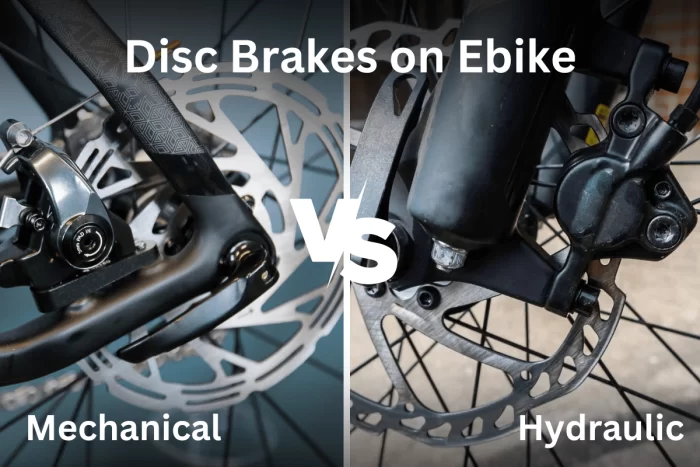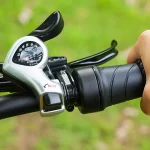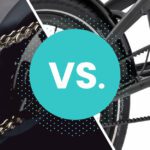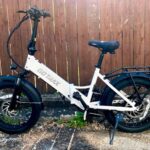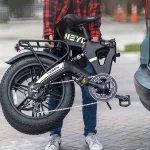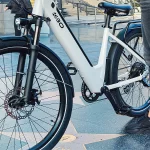Electric bikes (e-bikes) are becoming increasingly popular as an environmentally friendly and convenient method of transportation. When choosing an e-bike, one important decision is which type of brakes to get – hydraulic or mechanical. Both have their pros and cons in terms of performance, maintenance, cost, weight, and other factors. In this article we talk about Hydraulic Brakes Vs Mechanical Brakes for Electric Bikes.
Table of Contents
How Do Hydraulic Brakes Work?
Hydraulic brakes use fluid to transfer pressure from the brake lever to the brake pads which clamp onto the rotor to slow or stop the wheels from turning. When you pull the brake lever, it pushes a piston in the master cylinder which forces hydraulic brake fluid through the hose or line into the caliper containing more small pistons. The caliper pistons then push the brake pads against the rotor.
Hydraulic fluid is essentially incompressible so it transfers the brake force very efficiently without losing much power or feel. This gives hydraulic brakes excellent modulation and responsiveness – you can finely tune and vary the braking pressure with a light touch. They self-adjust for pad and rotor wear, keeping the lever feel and braking power consistent. Bleeding might be required if air bubbles get into the lines.
Overall, hydraulic disc brakes offer superior stopping power, control, consistency and all-weather performance compared to other brake types. The fluid transmission and multiple pistons allow very high clamping forces from a single finger pull on the level. However, they are generally more expensive and require a bit more maintenance.
How Do Mechanical Brakes Work?
Mechanical brakes use a steel cable or rod to connect the brake lever to the caliper instead of hydraulic fluid. When you pull the brake lever, it pulls the mechanical cable which activates arms in the caliper to push the pads onto the rotor. Mechanical disc brakes come in cable-actuated hydraulic varieties and pure mechanical types.
In cable-actuated hydraulic brakes, the cable pull causes a piston in the caliper to push hydraulic fluid into another piston on the other side, clamping the pads onto the rotor. They offer modulation and feel closer to full hydraulic brakes but still have a cable connection.
Pure mechanical brakes lack any hydraulic components. The brake cable is connected directly to the caliper arms activating the pads. Without hydraulic force multiplication, they require more lever pressure and have on/off feel rather than modulation. But mechanical disc brakes are simpler, easier to maintain, and more affordable than hydraulic varieties.
Hydraulic Brakes vs Mechanical Brakes for E-Bikes
Several factors should be considered when choosing between hydraulic and mechanical brakes for your electric bike.
Braking Power
Hydraulic brakes offer superior braking power and performance over any mechanical system. The hydraulic fluid provides efficient force transfer enabling high clamping force from a light lever pull. Mechanical brakes can’t match the raw stopping power of hydraulics.
Control and Modulation
The feel and control is another advantage of hydraulics. You can finely modulate the braking pressure for precise speed control in all conditions. Mechanical brakes have more on/off feel making smooth braking tricky. However, some riders may prefer the simplicity.
Weather Resistance
Hydraulic brakes maintain consistent and reliable braking in all weather conditions including rain, snow and mud. Mechanical brakes and cables are more prone to weather effects reducing power and feel. Hydraulic brakes offer all-season braking confidence.
Self-Adjustment
Hydraulics automatically self-adjust for pad wear maintaining consistent lever feel and braking power until the pads are fully worn. Mechanical brakes require manual adjustment to account for pad and cable stretch over time.
Heat Management
The hydraulic fluid also helps dissipate and transfer heat away from the pads and rotors for excellent heat management. Mechanical brakes are more prone to fading and reduced power under heavy braking. Hydraulics have superior performance for steep hills or frequent braking.
Ease of Maintenance
Mechanical brakes win in terms of simplicity and maintenance. Replacing pads or cables is straightforward for home mechanics. Hydraulic systems require more care, specialty tools, and know-how for bleeding, hose replacement or fluid changes.
Reliability
Hydraulic brakes do require periodic maintenance like bleeding but offer reliable operation for thousands of miles between services. Mechanical brakes and cables wear over shorter periods requiring more frequent adjustments or replacements.
Weight
Hydraulic brakes tend to weigh slightly more than mechanical setups. But weight differences are usually just 50-150g depending on the e-bike model and components. Going mechanical won’t make a huge dent.
Cost
The hydraulic systems have more parts and complex manufacturing leading to higher retail costs. Complete mechanical brake setups cost less in most cases making them the choice for budget e-bikes. Hydraulics are viewed as a premium upgrade.
E-Bike Suitability
For powerful electric bikes and mountain bikes reaching higher speeds, hydraulic brakes are highly recommended. The unrivaled power and modulation helps control faster e-bikes, especially downhill. Some less expensive commuter e-bikes may spec cheaper mechanical brakes to meet a lower price point. Mechanicals can be suitable for slower urban use.
Bleeding and service procedures may be more difficult for hydraulic systems, so mechanical brakes may be preferred if you won’t be doing your own maintenance. Ultimately hydraulic brakes offer better performance, but mechanical systems keep costs down and service simpler.
Conclusion
Hydraulic brakes provide e-bikes with superior stopping power, fine control and modulation, excellent reliability and all-weather performance. The hydraulic fluid transfers force very efficiently to allow strong braking from a light lever pull. However, they have slightly higher weight and costs compared to mechanical alternatives.
Mechanical brakes appeal in their simplicity, lower price and ease of service. But overall braking performance, power and feel can’t match high-end hydraulic systems. Mechanical brakes require more lever pressure, frequent adjustment and lack weather resistance.
For powerful electric bikes intended for speed, hills or variable conditions – hydraulic brakes are strongly recommended for safety. They give riders more confidence and control. But casual urban e-bike riders may find mechanical systems adequate to save on upfront and maintenance costs. I sincerely hope you find this “Hydraulic Brakes Vs Mechanical Brakes for Electric Bikes” article helpful.
🔋 More From ElectricBikePlanet
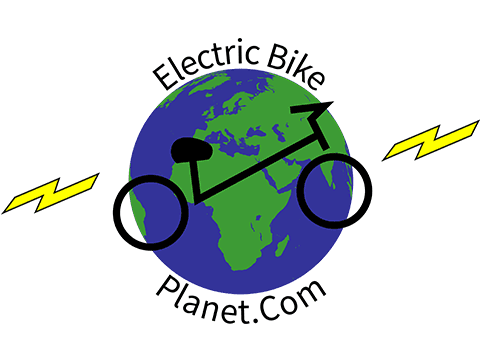
Captain Colyer is an expert in sustainable transportation with a Master’s degree in Environmental Engineering. With over 9 years of experience, he is dedicated to advancing eco-friendly commuting solutions. His work focuses on the latest advancements in electric bike technology and promoting sustainable living practices. At ElectricBikePlanet.com, Captain Colyer shares his in-depth knowledge and practical insights to help readers make informed decisions about electric bikes. Join them on their electric journey for the best e-bike advice and recommendations, and connect on Facebook, Pinterest, and Instagram.

